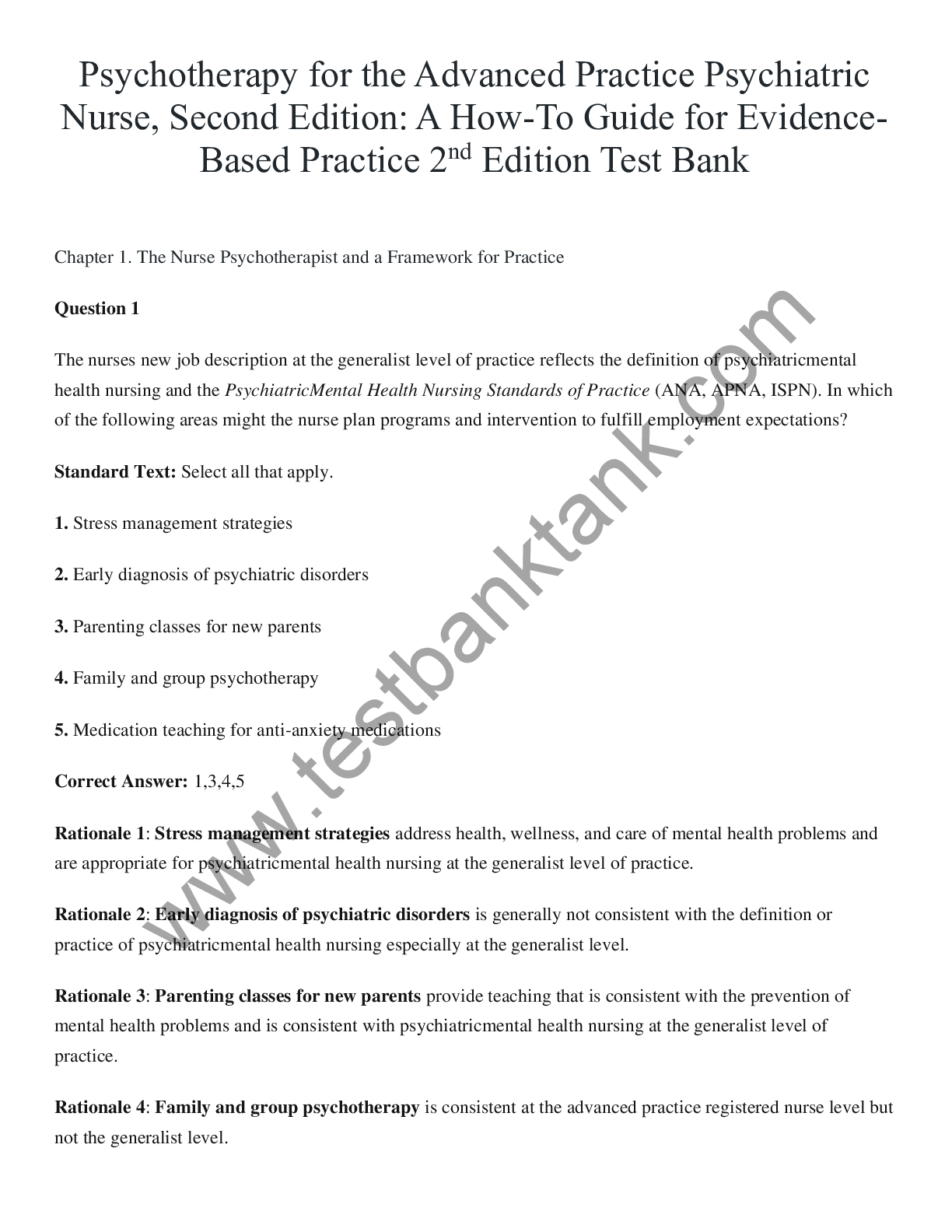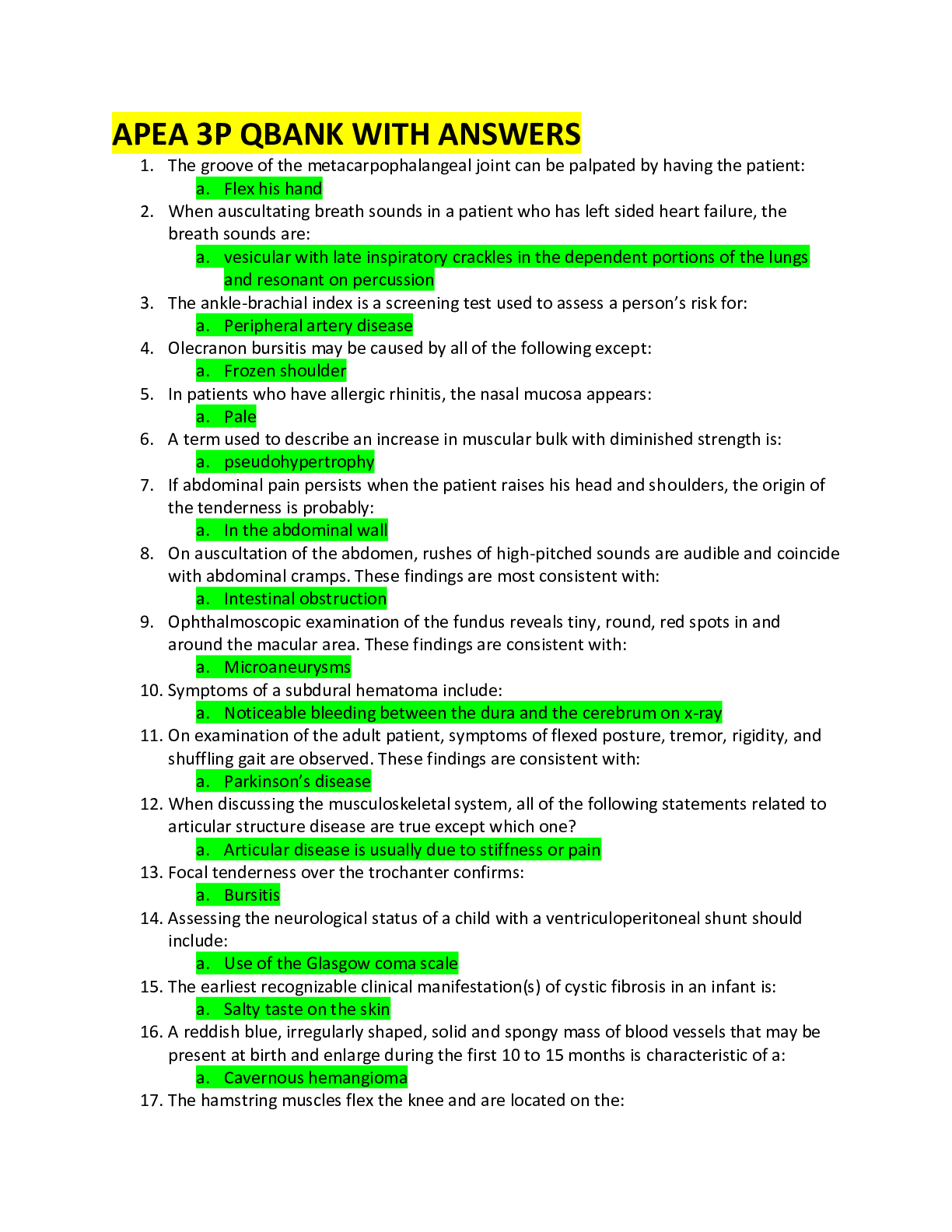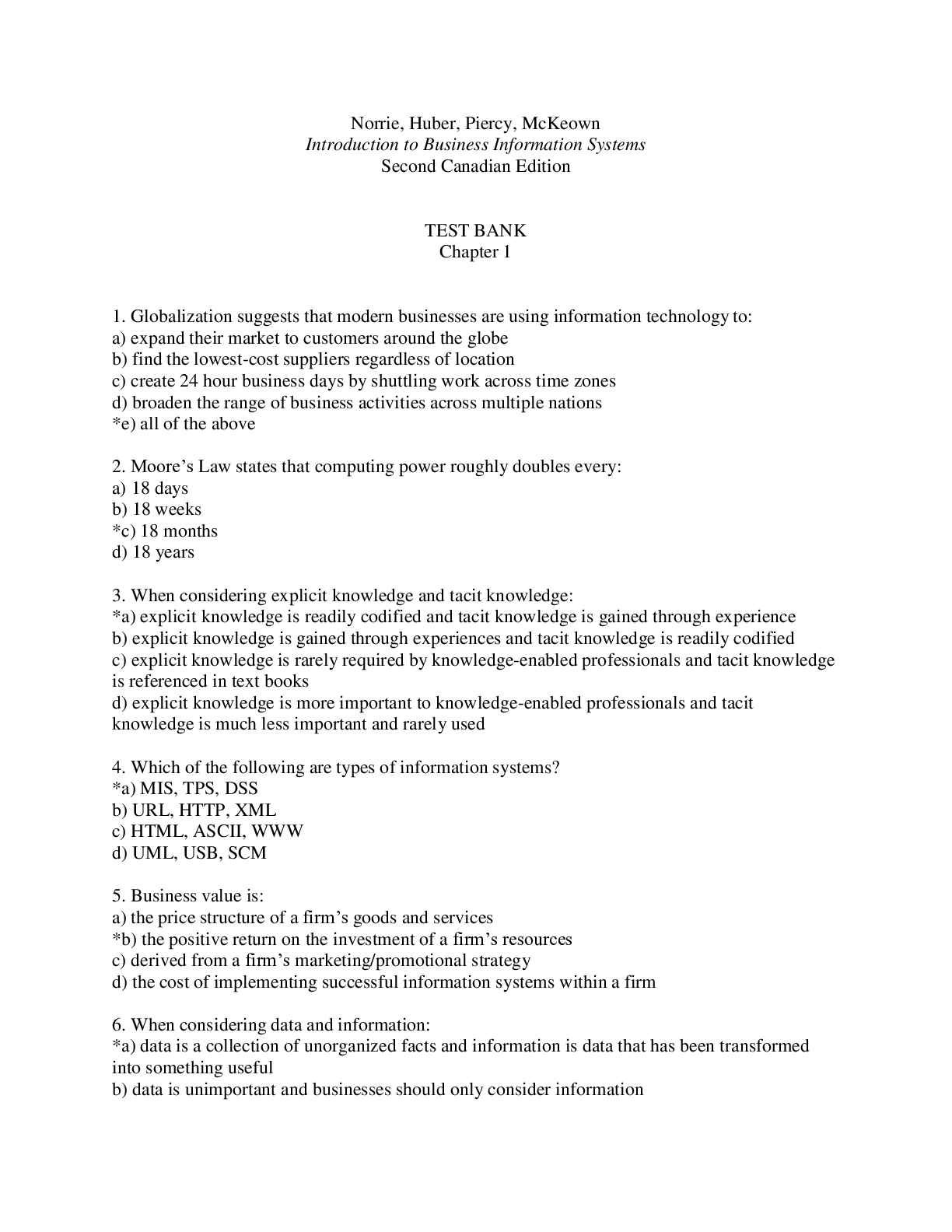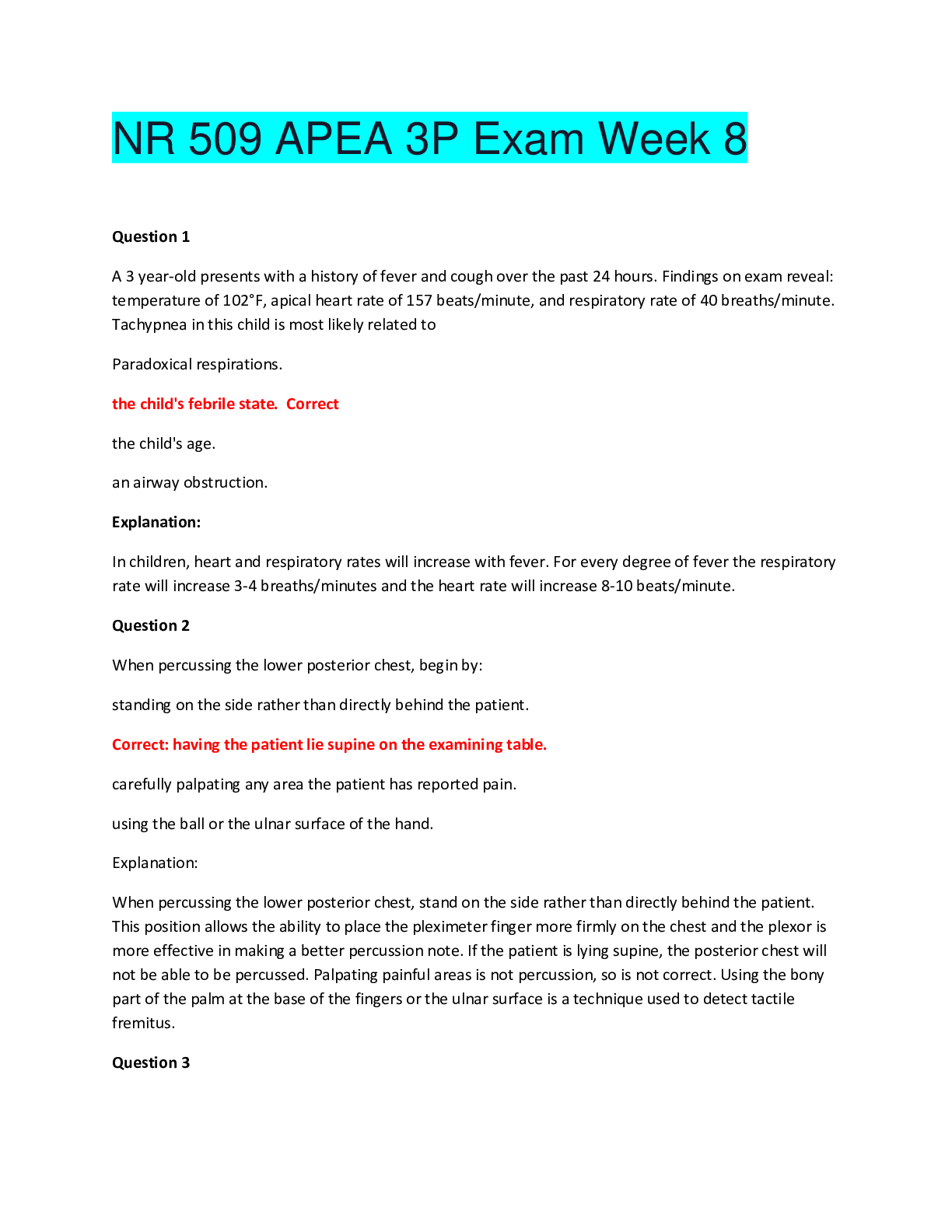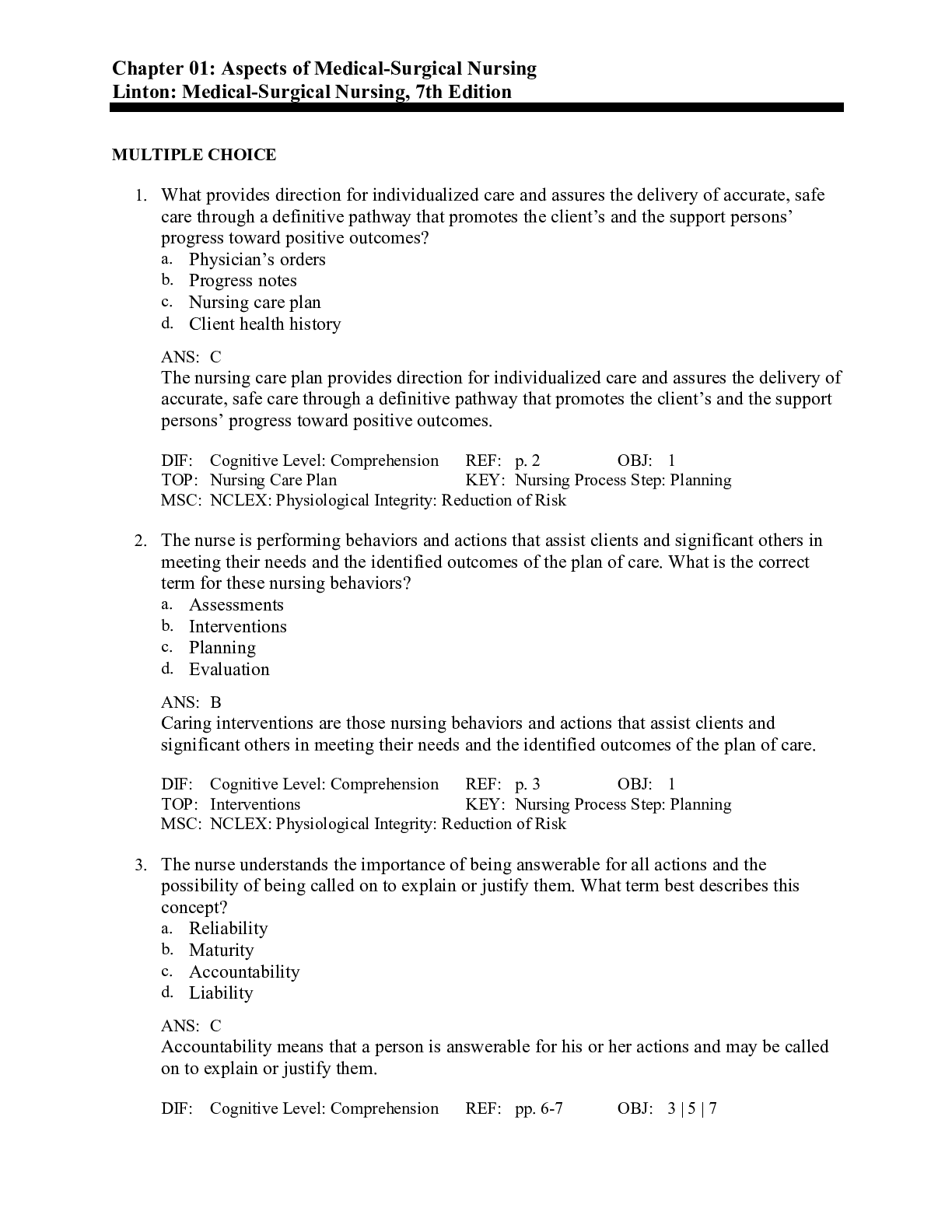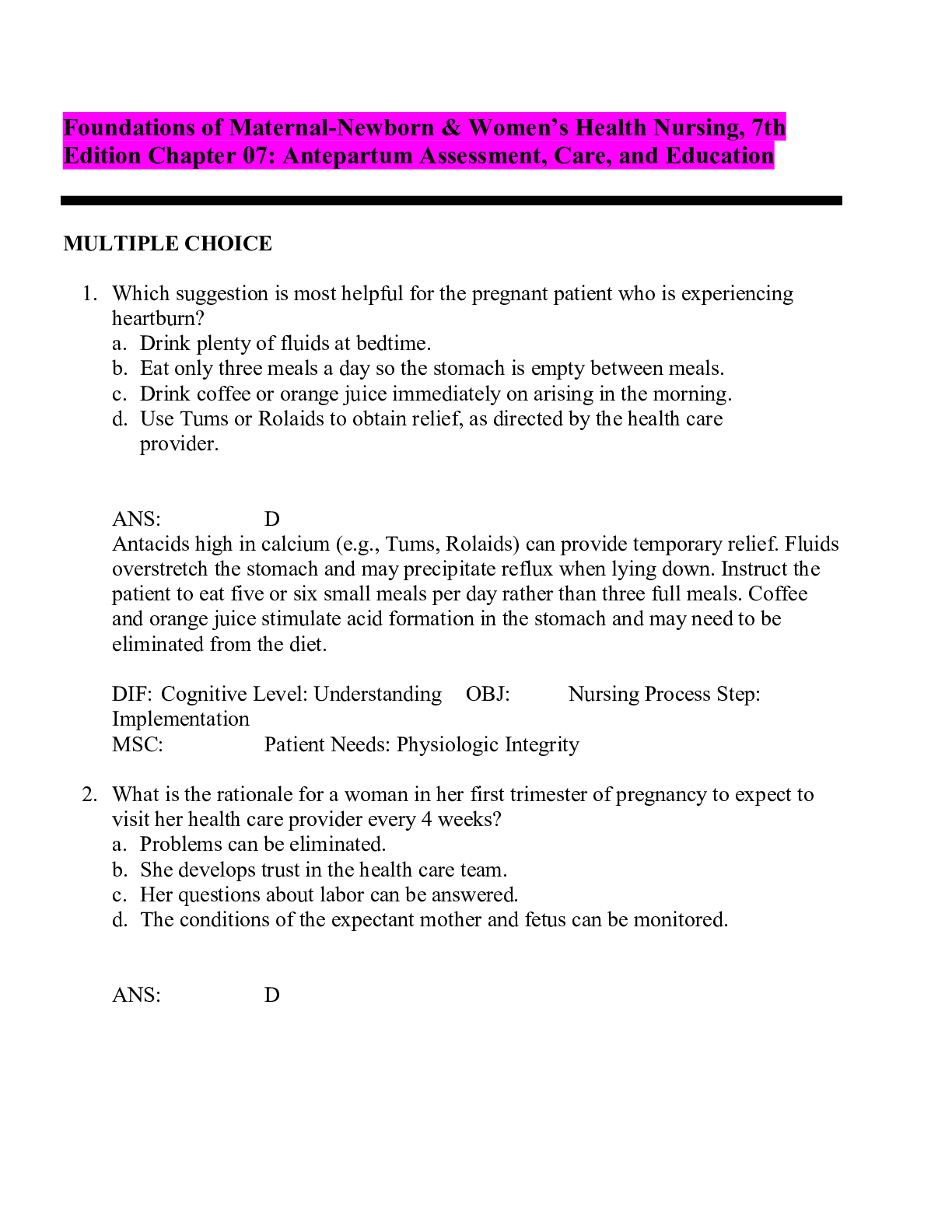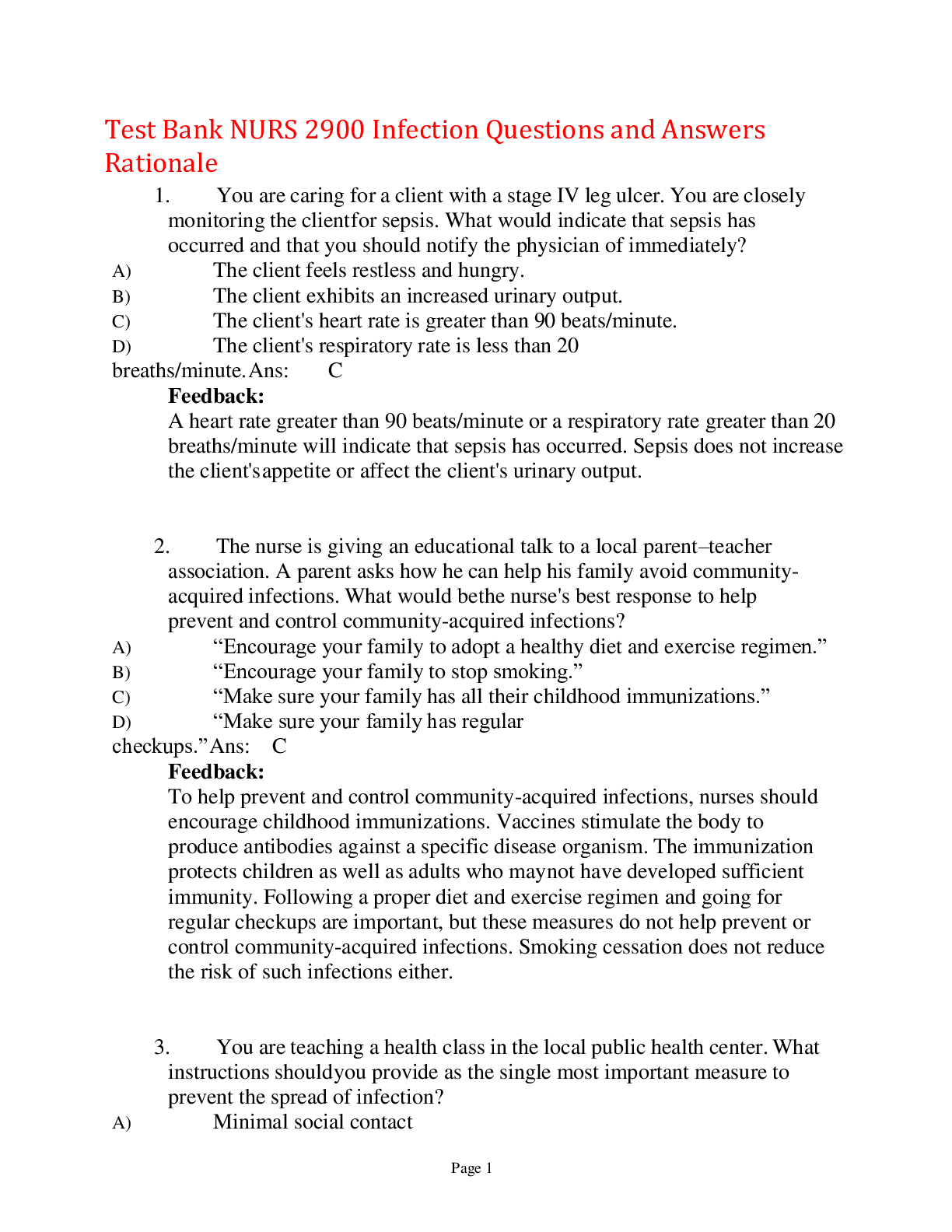*NURSING > TEST BANK > Potter & Perry: Fundamentals of Nursing, 7th Edition Test Bank/ Complete questions, answers & ration (All)
Potter & Perry: Fundamentals of Nursing, 7th Edition Test Bank/ Complete questions, answers & rationales
Document Content and Description Below
Potter & Perry: Fundamentals of Nursing, 7th Edition Test Bank Chapter 34: Infection Prevention and Control Nursing School Test Banks Potter & Perry: Fundamentals of Nursing, 7th Edition Test Bank M... ULTIPLE CHOICE 1. The client has a 6-inch laceration on his right forearm. The arm develops an infection. Which of the following is a sign of an acute inflammatory process? 1. A blanching of the skin 2. A decrease in temperature at the site 3. A decrease in the number of white blood cells 4. A release of histamine that adds to the pain response ANS: 4 A sign of an acute inflammatory process is pain. The swelling of inflamed tissues increases pressure on nerve endings, causing pain. Chemical substances such as histamine also stimulate nerve endings, adding to the pain response. The skin is not blanched; but rather, with the increase in local blood flow; it is reddened. The symptom of localized warmth results from a greater volume of blood at the inflammatory site. The cellular response of acute inflammation involves WBCs arriving at the site. There is an increase in WBCs, rather than a decrease. 2. A female client has been undergoing diagnostic testing since admission to the medical unit in the hospital. The results of blood testing are sent back to the unit. Upon reviewing the results, the nurse will report which of the following findings to the physician, which is abnormal? 1. Erythrocyte sedimentation rate (ESR) 35 mm/hr 2. White blood cell (WBC) count 8000/mm3 3. Neutrophils 65% 4. Iron 75 g/100 mL ANS: 1 The normal erythrocyte sedimentation rate for women is 20 mm/hr. The client’s ESR is 35 mm/hr., indicating the presence of the inflammatory process. The normal WBC count is 5000-10,000/mm3. The client is within normal limits at 8000/mm3. The normal neutrophil count is 55-70%. The client is within normal limits at 65%. The normal iron level is 60-90 g/100 mL. The client is within normal limits at 75 g/100 mL. 3. The nurse is observing the new staff member work with the client. Of the following activities, which one has the greatest possibility of contributing to a nosocomial infection and requires correction? 1. Washing hands before applying a dressing 2. Taping a plastic bag to the bed rail for tissue disposal 3. Placing a Foley catheter bag on the bed when transferring a client 4. Using alcohol to cleanse the skin before starting an intravenous line ANS: 3 The staff member who places the Foley catheter bag on the bed when transferring the client is placing the client at risk for a nosocomial infection because urine in the catheter or drainage tube may reenter the bladder (reflux). Washing hands before applying a dressing is a correct action to help prevent a nosocomial infection. Taping a plastic bag to the bed rail for tissue disposal is a correct action to aid the client in proper disposal of secretions. Using alcohol to cleanse the skin before starting an intravenous line is a correct action to prevent a nosocomial infection of the bloodstream. 4. Droplet precautions will be instituted for the client admitted to the infectious disease unit with: 1. Streptococcal pharyngitis 2. Herpes simplex 3. Pertussis 4. Measles ANS: 1 Droplet precautions are instituted when droplets are larger than 5 micrometers, such as in the case of streptococcal pharyngitis. Contact precautions are instituted for herpes simplex. Airborne precautions are instituted with pulmonary TB. Airborne precautions are instituted with measles. 5. In a small rural hospital they work with a wide variety of clients. Of this afternoon clients admitted, the nurse acknowledges the client with the highest susceptibility to infection is the individual with: 1. Burns 2. Diabetes 3. Pulmonary emphysema 4. Peripheral vascular disease ANS: 1 Burn clients have a very high susceptibility to infection because of the damage to skin surfaces. This would be the individual with the highest risk for infection. Victims of chronic diseases such as diabetes mellitus and multiple sclerosis are susceptible to infection because of general debilitation and nutritional impairment. Diseases that impair body system defenses, such as emphysema and bronchitis (which impair ciliary action and thicken mucus), increase susceptibility to infection. Diseases that impair body system defenses, such as peripheral vascular disease (which reduces blood flow to injured tissues), increase susceptibility to infection. 6. A nurse must display understanding of the mental implications of a client on isolation precautions when planning care to control the risk of: 1. Denial 2. Aggression 3. Regression 4. Isolation ANS: 4 A sense of loneliness may develop because normal social relationships become disrupted. The nurse should plan care to control the risk of the client feeling isolated. Denial is not a risk related to isolation. Aggression is not a risk for the client on isolation precautions. Regression is not a risk related to isolation. 7. Surgical aseptic techniques are employed by a nurse when: 1. Inserting an intravenous catheter 2. Placing soiled linen in moisture-resistant bags 3. Disposing of syringes in puncture-proof containers 4. Washing hands before changing a dressing ANS: 1 Surgical asepsis should be used during procedures that require intentional perforation of the client’s skin, such as with the insertion of IV catheters. The nurse is employing medical aseptic technique when placing soiled linen in moisture-resistant bags. The nurse is employing medical aseptic technique when disposing of syringes in puncture-proof containers. The nurse is employing medical aseptic technique when washing hands before changing a dressing. 8. A nurse is changing the dressing and accidentally drops the packing onto the client’s abdomen. The client has a large, deep abdominal incision that is packed with sterile half-inch packing and covered with a dry 4 x 4 gauze. The nurse should: 1. Add alcohol to the packing and insert it into the incision 2. Throw the packing away, and prepare a new one 3. Pick up the packing with sterile forceps, and gently place it into the incision 4. Rinse the packing with sterile water, and put the packing into the incision with sterile gloves ANS: 2 A sterile object (the packing) remains sterile only when touched by another sterile object. The client’s abdomen is not sterile; therefore, the nurse should throw the packing away and prepare a new one. The nurse should not add alcohol to the packing and insert it into the incision. The packing is considered contaminated as it touched a nonsterile surface and should be discarded. The nurse should not rinse the packing with sterile water and put the packing into the incision as it is considered contaminated. It touched a nonsterile surface. The nurse should throw the packing away and prepare a new one. 9. A client has a viral infection. Which of the following is typical of the illness stage of the course of her infection? 1. There are no longer any acute symptoms. 2. An oral temperature reveals a febrile state. 3. The client was first exposed to the infection 2 days ago but has no symptoms. 4. The client feels sick but is able to continue her normal activities. ANS: 2 During the illness stage the client manifests signs and symptoms specific to the type of infection. The client with a viral infection would likely exhibit a fever. There are no longer any acute symptoms during the convalescent period. An example of a client in the incubation period is when the client was first exposed to the infection 2 days ago, but has no symptoms. The client who feels sick but is able to continue normal activities is in the prodromal stage of a course of infection. 10. The nurse recognizes that special care must be taken in the handling of which of the following to prevent the transmission of hepatitis A? 1. Blood 2. Feces 3. Saliva 4. Vaginal secretions ANS: 2 To prevent the transmission of hepatitis A, the nurse needs to take special care when handling feces. Hepatitis B and C may be found in blood. Hepatitis A is not found in saliva. Hepatitis A is not found in vaginal secretions. 11. The parent of a preschool child asks the nurse how chickenpox (varicella zoster) is transmitted. The nurse identifies that the virus is: 1. Carried by a vector organism 2. Carried through the air in droplets after sneezing or coughing 3. Transmitted through person-to-person contact 4. Acquired through contact with contaminated objects ANS: 2 Varicella zoster virus (chickenpox) is transmitted by droplets carried through the air after sneezing or coughing. Varicella zoster virus (chickenpox) is not transmitted by a vector. Person-to-person contact is not responsible for varicella zoster virus (chickenpox) transmission. The transmission of varicella zoster virus (chickenpox) does not occur by contact with contaminated objects. 12. While working with clients in the postoperative period, the nurse is very alert to the results of laboratory tests. Which one of the following results is indicative of an infectious process? 1. Iron 80 g/100 mL 2. Neutrophils 65% 3. White blood cells (WBC) 18,000/mm3 4. Erythrocyte sedimentation rate (ESR) 15 mm/hr ANS: 3 An elevated WBC count is indicative of an acute infection. The normal WBC count is 5000 to 10,000/mm3. The normal neutrophil count is 55%-70%. The client is within normal limits at 65%. The normal iron level is 60-90 g/100 mL. The client is within normal limits at 80 g/100 mL. The normal erythrocyte sedimentation rate (ESR) is up to 15 mm/hr for men and up to 20 mm/hr for women. The client is within normal limits at 15 mm/hr. 13. Which of the following is an example of a nursing intervention that is implemented to reduce a reservoir of infection for a client? 1. Covering the mouth and nose when sneezing 2. Wearing disposable gloves 3. Isolating client’s articles 4. Changing soiled dressings ANS: 4 To control or eliminate reservoir sites for infection, the nurse eliminates or controls sources of body fluids, drainage, or solutions that might harbor microorganisms. The nurse also carefully discards articles that become contaminated with infectious material such as in changing soiled dressings. Covering the mouth and nose when sneezing is an intervention to control a portal of exit. Wearing disposable gloves helps protect the susceptible host. Isolating client’s articles is an intervention to control transmission. 14. In preventing and controlling the transmission of infections, the single most important technique is: 1. Hand hygiene 2. The use of disposable gloves 3. The use of isolation precautions 4. Sterilization of equipment ANS: 1 The most important and most basic technique in preventing and controlling transmission of infections is hand hygiene. Use of disposable gloves may help reduce the transmission of infections, but is not the single most important technique to prevent and control the transmission of infections. The use of isolation precautions is not the single most important technique to prevent and control the transmission of infections. Sterilization of equipment is not the single most important technique to prevent and control the transmission of infections. 15. A client with active tuberculosis is admitted to the medical center. The nurse recognizes that admission of this client to the unit will require the implementation by the staff of: 1. Airborne precautions 2. Droplet precautions 3. Contact precautions 4. Reverse isolation ANS: 1 A client with active tuberculosis requires airborne precautions. A client with active tuberculosis does not require droplet precautions, as the droplet nuclei of tuberculosis are smaller than 5 micrometers. Contact precautions are not necessary for the client with active tuberculosis. Reverse isolation is not required for the client with active tuberculosis 16. The nurse recognizes the appropriate procedures for sterile asepsis. Of the following, which action is consistent with sterile asepsis? 1. Clean forceps may be used to move items on the sterile field. 2. Sterile fields may be prepared well in advance of the procedures. 3. The first small amount of sterile solution should be poured and discarded . 4. Wrapped sterile packages should be opened starting with the flap closest to the nurse. ANS: 3 Before pouring the solution into the container, the nurse pours a small amount (1 to 2 mL) into a disposable cap or plastic-lined waste receptacle. The discarded solution cleans the lip of the bottle. This action is consistent with sterile asepsis. Sterile forceps should be used to move items on a sterile field when using sterile asepsis. Sterile fields should not be prepared well in advance of a sterile procedure. A sterile object or field becomes contaminated by prolonged exposure to air. Wrapped sterile packages should be opened starting with the flap farthest away from the nurse (i.e., the top flap). 17. Older adult clients may react differently to infectious processes and a nurse suspects that her older adult client may be experiencing hypostatic pneumonia. The nurse must be alert to atypical signs and symptoms, such as: 1. Hypotension 2. Confusion 3. Erythema – inflammation of skin cells 4. Chills ANS: 2 An infection in older adults may not present with typical signs and symptoms. Atypical symptoms such as confusion, incontinence, or agitation may be the only symptoms of an infectious illness. An unexplained increased heart rate, confusion, or generalized fatigue may be the only symptoms of pneumonia in the older adult. Hypotension is not one of the atypical symptoms of an older adult experiencing infection. It may be a symptom of a systemic infection related to an elevation in body temperature (regardless of age). Erythema is a typical symptom of a localized infection. Chills are a typical symptom of a systemic infection. 18. What is the correct order for a nursing assistant for putting on the protective equipment when caring for a client in isolation? 1. Wash her hands, apply the mask and eyewear, put on the gown, and then apply gloves 2. Apply the mask and eyewear, put on the gown, wash her hands, and then apply gloves 3. Wash her hands, put on the gown, apply the mask and eyewear, and then apply the gloves 4. Put on the gown, apply the mask and eyewear, wash her hands, and then apply gloves ANS: 1 The correct sequence for putting on protective equipment is to perform hand hygiene, apply the mask and eyewear, apply gown, and then apply gloves. Apply the mask and eyewear, put on the gown, wash her hands, and then apply gloves; wash her hands, put on the gown, apply the mask and eyewear, and then apply the gloves; put on the gown, apply the mask and eyewear, wash her hands, and then apply gloves are not the correct sequences for putting on protective equipment. 19. A client has requires a mid-abdominal surgical incision which necessitates a sterile dressing. An appropriate intervention for the nurse to implement in maintaining sterile asepsis is to: 1. Put sterile gloves on before opening sterile packages 2. Discard packages that may have been in contact with the area below waist level 3. Place the cap of the sterile solution well within the sterile field 4. Place sterile items on the very edge of the sterile drape ANS: 2 A sterile object held below a persons waist is considered contaminated. To maintain sterile asepsis, packages that may have been in contact with the area below waist level should be discarded. Sterile gloves are not put on before opening sterile packages as the outside of the packages is not sterile. The nurse uses hand hygiene and opens sterile packages, being careful to keep the inner contents sterile. After a cap or lid is removed, it is held in the hand or placed sterile side (inside) up on a clean surface. A bottle cap or lid should never rest on a sterile surface, even though the inside of the cap is sterile. The edges of a sterile field are considered to be contaminated. Sterile items should be placed in the middle of the sterile field to maintain sterile asepsis. 20. The nurse is preparing to assist with a sterile procedure in the surgical suite. An appropriate technique that the nurse includes in the surgical scrub is to: 1. Keep the hands below the elbows throughout the scrub 2. Use a brush on the palms and dorsal surface of the hands 3. Maintain the scrub for at least 2 to 5 minutes 4. Wash well around all jewel ANS: 3 A surgical scrub should be maintained for at least 2 to 5 minutes. To avoid contamination during a surgical hand scrub, the nurse holds the hands above the elbows. Several studies suggest that neither a brush nor a sponge is necessary to reduce bacterial counts on the hands, especially when an alcohol-based product is used. For maximum elimination of bacteria, all jewelry should be removed. 21. An appropriate isolation procedure for the nurse to implement when working with a client who is found to have methicillin-resistant Staphylococcus aureus (MRSA) is to: 1. Leave all linen in the client’s room 2. Place specimen containers in plastic bags for transport 3. Wipe the stethoscope off before removing it from the room 4. Remove the mask and goggles first when leaving the clients room ANS: 2 Specimen containers should be placed in plastic bags for transport with a label on the outside of the bag. Linen should be placed in an impervious linen bag and may be removed from the client’s room. Bags should be tied securely at the top with a knot. For the person infected with MRSA, equipment remains in the room. After discharge or with the discontinuation of isolation, client care equipment is properly cleaned and reprocessed and single-use items are discarded. Gloves should be removed first when leaving the clients room. 22. A client is found to have a bacterial infection of Escherichia coli. The nurse, recognizing the effects of this bacterium, anticipates that the client will demonstrate: 1. Diarrhea 2. Coughing 3. Cold sores around the mouth 4. Discharge from the eyes ANS: 1 Escherichia coli causes gastroenteritis and urinary tract infections. The client with E. coli infection is likely to demonstrate diarrhea. E. coli is found in the colon, not the respiratory tract. Cold sores are seen with herpes simplex virus (type 1), not with E. coli. Discharge from the eyes is not seen with E. coli infection. It may be seen with Neisseria gonorrhea. 23. Which of the following clients is at greatest risk for acquiring an infection? 1. A 56-year-old with a urinary catheter 2 days after prostatectomy 2. A 27-year-old diagnosed with human immunodeficiency virus (HIV) 3. A 43-year-old who is 3 days post appendectomy and is currently afebrile –without fever 4. A 16-year-old with a compound fractured femur as a result of a bike accident ANS: 4 Clients are at risk for acquiring infections because of lower resistance to infectious microorganisms, increased exposure to numbers and types of disease-causing microorganisms, and invasive procedures. The exposure to earth-bound microorganisms makes the compound fracture client at the greatest risk since that risk is uncontrollable. 24. A nurse is caring for a client who has colonized methicillin-resistant Staphylococcus aureus (MRSA). Which of the following statements reflects the best understanding of the client’s condition? 1. This client has the bacteria present but it hasn’t become infected. 2. This makes the clients MRSA very infectious and so a danger to others. 3. Just be sure to follow standard precautions and there won’t be a problem. 4. The client needs to be watched closely for a conversion to active MRSA. ANS: 1 If a microorganism is present or invades a host, grows, and/or multiplies but does not cause infection, this is referred to as colonization. 25. The greatest drawback to the routine use of antibacterial hand soaps and gels is that they: 1. Are expensive 2. Irritate the skin 3. Kill resident flora 4. Encourage resistant bacteria ANS: 3 Antibacterial products kill resident flora and that can lead to the development of infection. The remaining options may be true but they are not the primary negative outcome of the regular use of antibacterial hand cleansing products. 26. The nurse knows that Staphylococcus aureus found normally on the skin of a client who has had surgery poses a particular risk for that client developing: 1. A cold sore 2. Gastroenteritis 3. A wound infection 4. A urinary tract infection ANS: 3 Staphylococcus aureus found normally on/in skin, hair, anterior nares, and the mouth can result in wound infections, pneumonia, food poisoning, and cellulitis. Streptococcus (-hemolytic group B) organisms may result in urinary tract infections or gastroenteritis while herpes simplex is viral in nature. 27. What is the most appropriate answer to the client’s question, What is the difference between antibacterial and antimicrobial hand soaps? 1. There is no real difference; use the less expensive. 2. Antibacterial soaps are more effective at preventing infections. 3. Antimicrobial soap is better since it won’t kill the good bacteria on the skin. 4. Any soap will do; it’s the technique for proper hand washing that is the key. ANS: 3 The use of antimicrobial hand hygiene products is recommended because they remove transient organisms but leave resident flora intact. There is a difference in the products and it is true that the effectiveness of hand hygiene is dependent on proper technique, but the clients question is best answered by the information provided in option 3. 28. A presurgical client asks the nurse why it seems so easy to get an infection in the wound after surgery. The nurse’s most appropriate response to this question is: 1. The contaminated dressing acts as a breeding ground for microorganisms that then infect the wound. 2. The body’s immune system is weakened by the surgery and can’t fight off the infection as effectively. 3. While infections occur, there are many very effective antibiotics available to help minimize the risk of that happening. 4. The surgical wound provides the microorganisms on the surrounding skin a path to enter deep into the body’s tissues. ANS: 4 Resident skin microorganisms are not virulent. However, they can cause serious infection when surgery or other invasive procedures allow them to enter deep tissues. While the other options are not incorrect, they do not answer the clients question as effectively. 29. The nurse obtains a new, dry nebulizer when preparing to give an elderly asthmatic client a nebulizer treatment because the risk of infection is increased because: 1. The client’s age increases the risk factor for potential infection 2. The client’s immune system is compromised as a result of asthma 3. There is a potential presence of Pseudomonas organisms in the reservoir 4. There is a chance for microorganisms to enter the body via the respiratory system ANS: 3 Pseudomonas organisms survive and multiply in nebulizer reservoirs used in the care of clients with respiratory problems. While the remaining options are correct, they are not the primary reason for getting a new, dry nebulizer. 30. A client is told that he is a carrier of the hepatitis B virus. When asked to explain this situation in more detail, the nurse’s best response is: 1. You need to be careful not to pass the virus to other people. 2. You aren’t sick, but you do have the virus within your body. 3. Be tested often so as to monitor whether the virus becomes active. 4. While you show no signs of the illness, you can pass the virus to others. ANS: 4 Carriers are persons who show no symptoms of illness but who have pathogens on or in their bodies that are transferred to others. While the other options are not incorrect, they do not address the clients questions as directly as does the answer. 31. The nurse can best minimize the risk for infection when initiating an intravenous site by: 1. Proper vein site selection 2. Effective topical skin preparation 3. Appropriate site dressing 4. Gloving for the procedure ANS: 2 When a needle pierces a clients skin regardless of the location, organisms enter the body if proper skin prepping was not performed. The remaining options have an effect on infection control but not to the degree that skin prepping does. 32. A client enters a neighborhood walk-in clinic reporting the symptoms of a head cold. When the health care provider does not prescribe an antibiotic, the client asks the nurse to explain why not. The nurse’s most appropriate response is: 1. Antibiotics aren’t usually necessary for colds, and they are really very expensive if you don’t have insurance. 2. You know what they say; a cold will go away with medication in 2 weeks; without medication in 14 days. 3. Your health care provider believes in treating the symptoms since there are so many different strains of the common cold. 4. Common colds don’t usually require an antibiotic, and taking one results in making it harder to treat infections when they do occur. ANS: 4 Organisms with resistance to key antibiotics are becoming more common in acute care settings. This is associated with the frequent and sometimes inappropriate use of antibiotics. While the remaining options are not incorrect, they may seem insensitive or incomplete in answering the clients question. 33. The nurse is caring for a postoperative client with a localized sinus infection. The most appropriate means by which the nurse can minimize the risk of this client developing a systemic infection is to: 1. Adhere strictly to standard precaution techniques 2. Dispense prescribed anti-infective medication as ordered 3. Monitor the client regularly for exacerbation of the sinus infection 4. Review lab work daily to determine the presence of increased white cell count ANS: 1 If an infection is localized (e.g., a wound infection), use of standard precautions and personal protective equipment (PPE) will block the spread of infection to other sites, thus preventing an infection that affects the entire body instead of just a single organ or part (systemic). While the other options are not incorrect, they are not as directed at minimizing the risk of infection as is the answer. 34. The nurse and a client are discussing the client’s tendency to develop numerous colds during the winter months. The client’s health history reveals that he is a 1 pack a day smoker. Which of the following nursing statements is most appropriate regarding the possible relationship between the client’s cigarette smoking and the frequency of winter colds? 1. Smoking decreases your body’s immune system, and so you can’t fight off the colds as effectively. 2. If you stopped smoking you would have fewer colds and just generally feel better all year around. 3. The nicotine in the cigarettes has an effect on your blood vessels, decreasing the circulation of antibodies that would attack the cold viruses. 4. Smoking damages the little hairs in your nose and airways so they can’t trap the airborne cold viruses and keep them from entering your body. ANS: 4 Cilia lining the upper airway trap inhaled microbes and sweep them outward in mucus to be expectorated or swallowed. Smoking appears to paralyze these tiny hairs, and so they are not able to function effectively. Consequently, microbes including the cold viruses are able to enter into the respiratory tract. The other options present unproven theories, generalized statements, or less thorough explanations of the relationship between smoking and respiratory illnesses. ... [Show More]
Last updated: 1 year ago
Preview 1 out of 118 pages
Instant download
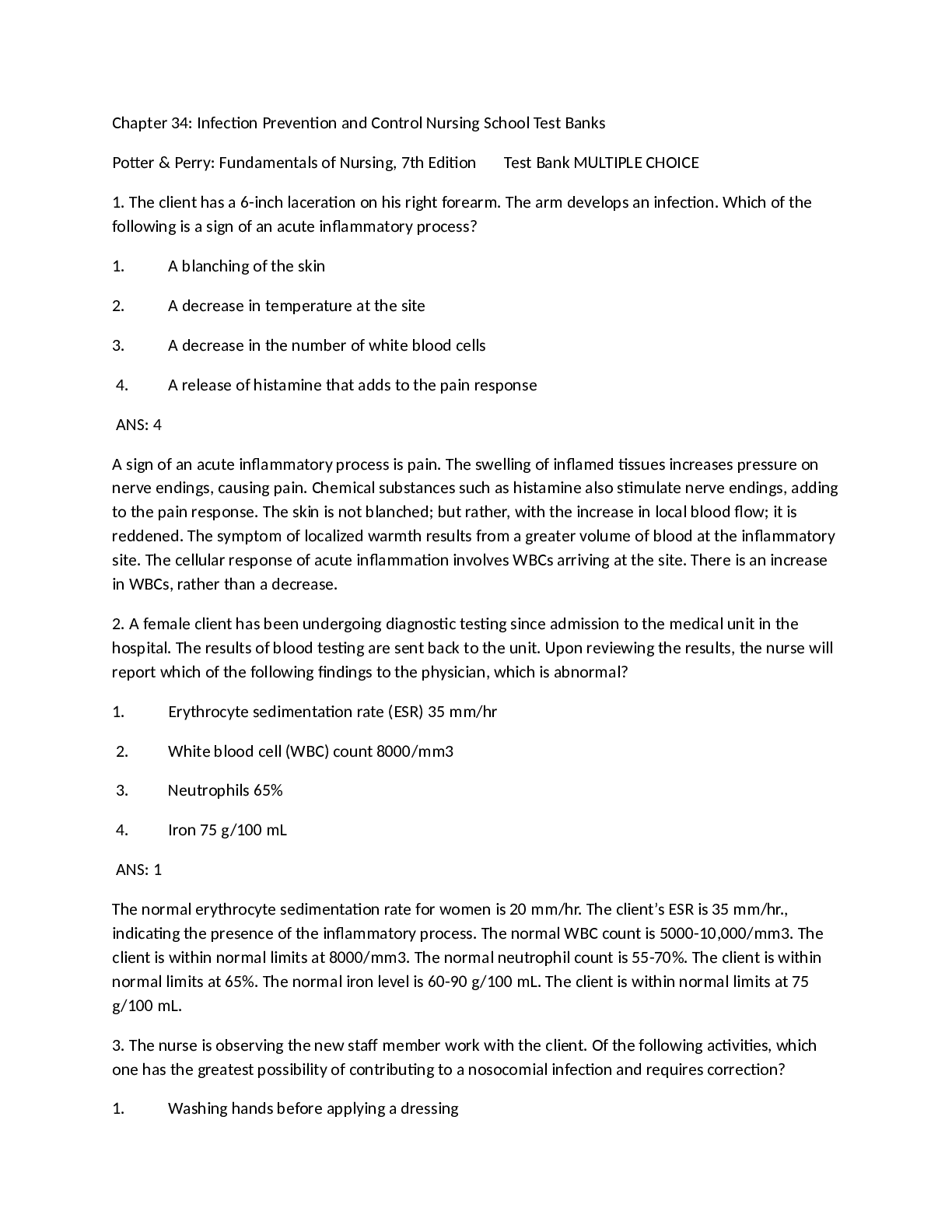
Buy this document to get the full access instantly
Instant Download Access after purchase
Add to cartInstant download
Reviews( 0 )
Document information
Connected school, study & course
About the document
Uploaded On
Jan 10, 2021
Number of pages
118
Written in
Additional information
This document has been written for:
Uploaded
Jan 10, 2021
Downloads
0
Views
47


